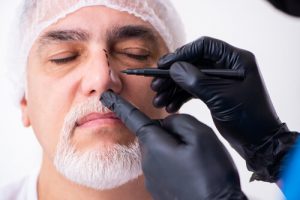A cartilage bump on tip of nose can be more than just a minor cosmetic concern—it often has deeper implications for appearance and self-esteem. This condition, where cartilage forms a visible bump at the end of the nose bridge of the nasal structure, invites many questions. What causes such a formation? Are there effective treatments or interventions?
In the following discussion, we will delve into the anatomy, possible origins, and innovative solutions for addressing a cartilage bump on the tip of the nose, uncovering the paths towards a more balanced and harmonious facial profile. Stay tuned as we explore the impact and corrective strategies for this distinctive nasal feature.
Introduction to Cartilage Bumps: What Are They?
A cartilage bump on the tip of the nose is a common aesthetic concern many seek to understand and address. Comprised primarily of cartilage and sometimes bone irregularities, this feature can significantly impact the harmony and symmetry of the patient and facial profile.
Anatomical Composition
The tip of the nose is predominantly cartilage, unlike the upper nasal structure, which includes the nasal bones. A bump in this area typically results from excess cartilage growth or minor deviations in the underlying structure, making the tip appear protruded or bulbous.
Associated Conditions
A cartilage bump on the nasal tip may be accompanied by other nasal deformities, such as a deviated septum or swollen soft tissue, which can further complicate the nasal appearance and function. These conditions can arise from genetic predispositions, trauma, or previous nasal surgeries.
Impact on Appearance and Function
While primarily a cosmetic issue, in some cases, these bumps can alter nasal function, affecting breathing and leading to conditions like bad allergies or respiratory conditions due to obstructed nasal passages.
Common Treatment Approaches
Treatment options range from non-surgical rhinoplasty, dermal fillers subtly reshape the nose, to surgical rhinoplasty—open and closed methods—depending on the complexity and the patient’s desired outcome. The choice of technique plays a significant role in addressing the bump’s aesthetic and functional aspects.
Considerations for Surgery
In surgical scenarios, considerations include the overall facial balance, skin thickness around the nasal tip, and potential impacts on the nasal septum. The doctor must carefully plan the procedure to ensure a natural look without compromising nasal function.
Causes of Cartilage Bumps on Tip of Nose
 The formation of cartilage bumps on the nasal tip is not merely a cosmetic concern; nose bumps can also indicate underlying anatomical variations or health issues. These bumps can significantly impact the overall nasal structure and facial aesthetics.
The formation of cartilage bumps on the nasal tip is not merely a cosmetic concern; nose bumps can also indicate underlying anatomical variations or health issues. These bumps can significantly impact the overall nasal structure and facial aesthetics.
Genetic Predisposition: Often, the structure of the nasal tip, including the presence of bumps, is inherited. Genetic factors can predetermine the shape and size of nasal cartilage, leading to pronounced bumps that are noticeable from an early age.
Developmental Changes: During adolescence, the nose undergoes significant growth and changes. Anomalies in the development of cartilage and bone during this period can result in irregularities, such as bumps at the nasal tip.
Trauma or Injury: Accidental impacts to the nose, such as those from sports, falls, or vehicle accidents, can alter the shape of the cartilage and lead to the formation of bumps. Even minor, repeated trauma from habits like glasses pressing on the nose can contribute over time.
Surgical Modifications: Previous nasal surgeries, especially those involving modifications to the nasal tip, can leave residual bumps. These may result from scar tissue, imperfect techniques, or incomplete healing post-.
Ageing Process: As individuals age, natural changes in skin elasticity and cartilage density can lead to the formation of bumps. The skin’s decreasing ability to smooth over underlying cartilage can make even minor irregularities more visible.
Symptoms and Diagnosis of a Cartilage Bump
A cartilage dorsal bump on the nose tip is often easily identifiable due to its external visibility. However, understanding its symptoms and securing a diagnosis is essential for determining the appropriate treatment path.
Visual Identification: The most apparent symptom of a cartilage bump is a visible protrusion or irregularity at the tip of the nose. This bump may affect the nose’s overall symmetry and profile, making it more noticeable from the front and side views.
Physical Discomfort: While not always painful, some individuals may experience discomfort or sensitivity around the bump, especially if it has been exacerbated by trauma or is subject to pressure from glasses.
Breathing Issues: Depending on its size and location, a cartilage bump can occasionally obstruct nasal passages or alter airflow, potentially leading to breathing difficulties, frequent nasal congestion, or exacerbate respiratory issues.
Self-Esteem Concerns: Beyond physical symptoms, a cartilage bump can also impact psychological well-being. Many individuals may feel self-conscious about their appearance, affecting social interactions and personal confidence.
Diagnostic Process
Physical Examination: The initial step in diagnosing a cartilage bump involves a thorough physical examination by a healthcare professional or a cosmetic doctor. This examination will assess the external structure of the nose, the skin’s condition, and any asymmetries.
Medical History: A detailed medical history helps to understand any genetic predispositions or prior trauma that might have contributed to the formation of the bump.
Imaging Tests: In some cases, imaging techniques such as X-rays, CT scans, or MRI may be utilised to gain a clearer understanding of the deeper nasal structures, including the cartilage and underlying bone, particularly if surgical intervention is considered.
Functional Tests: If there are concerns about the impact on nasal airflow, additional functional tests, such as a nasal airflow resistance test, might be conducted to assess any functional impairments caused by the bump.
Treatment Options for Removing or Reducing Cartilage Bumps
 Addressing a cartilage bump on the tip of the nose can significantly enhance facial symmetry and improve an individual’s self-esteem. Various treatment methods are available, allowing for customization based on the patient’s specific needs and the characteristics of the nose bump itself.
Addressing a cartilage bump on the tip of the nose can significantly enhance facial symmetry and improve an individual’s self-esteem. Various treatment methods are available, allowing for customization based on the patient’s specific needs and the characteristics of the nose bump itself.
Non-Surgical Options
Dermal Fillers: For minor bumps, dermal fillers can smooth out the nasal profile by adding volume around the bump, creating a more even surface. This method is temporary and typically lasts from six months to two years, depending on the type of filler used.
Steroid Injections: In some cases, corticosteroid injections can help reduce the size of the cartilage bump by decreasing inflammation and slowing cartilage growth. This option requires careful administration to avoid thinning the skin.
Surgical Options
Rhinoplasty: The most definitive treatment for a cartilage bump is rhinoplasty, which can be performed using open or closed techniques.
- Open Rhinoplasty: This technique involves an incision across the columella (the tissue between the nostrils), allowing the doctor extensive access to the nasal structure for precise modifications.
- Closed Rhinoplasty: Incisions are made within the nostrils, resulting in no visible scarring. This method is less invasive and often used for smaller adjustments.
Tip Plasty: For bumps confined to the tip of the nose, a tip plasty may be sufficient. This procedure focuses on reshaping the nasal tip without altering other nose parts.
Combination Therapies
Rhinoplasty with Cartilage Reshaping: In some cases, doctors may undergo dorsal hump removal to reshape the existing cartilage and, if necessary, use grafts from elsewhere to achieve the desired contour and structural support.
Laser Therapy: While not commonly used for cartilage and bone irregularities, laser treatments can refine the skin’s appearance on and around the nasal tip post-, especially if scar tissue is a concern.
Additional Considerations
Recovery Time: Non-surgical treatments typically involve minimal to no downtime, whereas surgical options require a recovery period during which swelling and bruising decrease before the final results are visible.
Longevity and Effects: Non-surgical options are temporary and may require ongoing treatments to maintain results, while surgical options usually provide permanent modifications to the nasal structure.
Cost and Investment: Surgical treatments are generally more costly upfront but are considered a long-term investment compared to the recurring expense of non-surgical treatments.
What to Expect After Treatment: Recovery and Results
 Post-treatment expectations for a cartilage bump on the nasal bridge of the nose vary significantly between non-surgical and surgical approaches. Each method has its timeline and specific care requirements, influencing the overall recovery and the visibility of results.
Post-treatment expectations for a cartilage bump on the nasal bridge of the nose vary significantly between non-surgical and surgical approaches. Each method has its timeline and specific care requirements, influencing the overall recovery and the visibility of results.
Non-Surgical Recovery
Immediate Resumption of Activities: Non-surgical treatments like dermal fillers and steroid injections typically allow patients to return to daily activities almost immediately. Minimal downtime is one of the significant advantages of these options.
Temporary Side Effects: Common side effects include slight bruising, swelling, or redness at the injection site, usually subsiding within a few days.
Short-Term Results: The effects of non-surgical treatments are visible almost immediately, though they will diminish over time, requiring repeat sessions to maintain the desired appearance.
Surgical Recovery
Initial Downtime: Surgical remedies such as rhinoplasty require significant initial downtime, with the first week being crucial for managing swelling and discomfort. Complete cessation of strenuous activities is recommended during this period.
Longer Healing Process: Swelling and bruising can persist for several weeks, with subtle changes and settling occurring over several months. The nasal shape may continue to refine even up to a year after .
Follow-Up Visits: Post-operative appointments are vital to monitor healing, remove stitches if necessary, and address any concerns. These visits also help ensure that recovery is progressing as expected.
Results and Satisfaction
Non-Surgical Outcomes: While immediate, the results from non-surgical treatments are temporary. Patients often schedule ongoing treatments to maintain their outcomes.
Surgical Outcomes: The results from surgical interventions are designed to be permanent, with the final shape of the nose becoming fully apparent once all swelling has resolved. Satisfaction with surgical results tends to be high, given the permanent correction of the structural deformity.
Emotional Impact: Both non-surgical and surgical treatments can profoundly impact self-esteem and body image. Patients frequently report increased confidence and satisfaction with their facial appearance.
In conclusion, addressing a cartilage bump on the tip of the nose enhances your facial aesthetics and boosts your confidence. Individuals can achieve a smoother, more proportionate nasal appearance with a range of effective treatments available, from non-invasive options to surgical corrections. Consult with a specialist to determine the best approach for your needs and take the first step towards refining your profile.
Ready to transform your look and address the cartilage bump on the tip of your nose? Call Rhinoplasty Sydney Cost today at (02) 8880 5116 to schedule your consultation. Discover the best treatment options tailored specifically for you and take the first step towards a refined, confident you!
References
Dorsal Humps (Bump on Nose): Causes and More – Healthline
https://www.healthline.com/health/dorsal-hump#:~:text=Dorsal%20humps%20are%20cartilage%20and,occurring%20bumps%20on%20the%20nose.
Why would I develop a bump (I think it’s excess cartilage)
https://www.realself.com/question/ohio-develop-bump-excess-cartilage-tip-nose-adulthood-fix
Nose tip | Ask A Surgeon – For Medical Professionals
https://www1.cosmetic.org/psconnect/askadoctor/detail.aspx?thread=707
Chondroma of the nasal tip
https://pubmed.ncbi.nlm.nih.gov/23524820/
Broad Nasal Tip Rhinoplasty
https://emedicine.medscape.com/article/839986-overview

